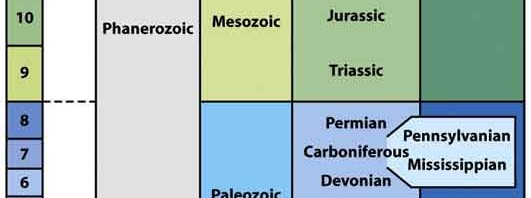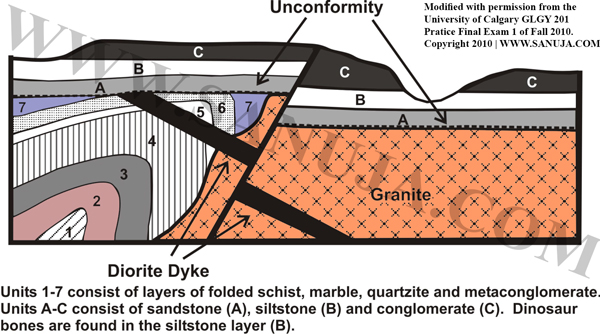Notice
If you get a question wrong, you can still click on the other answers. This will open up hints and explanations (if available), which will provide additional information.Disclaimer: While every reasonable effort is made to ensure that the information provided is accurate, no guarantees for the currency or accuracy of information are made. It takes several proof readings and rewrites to bring the quiz to an exceptional level. If you find an error, please contact me as soon as possible. Please indicate the question ID-Number or description because server may randomize the questions and answers.
Go to: Final Exam
Geology (GLGY 201-UCAL) Midterm Exam
Congratulations - you have completed Geology (GLGY 201-UCAL) Midterm Exam.
You scored %%SCORE%% out of %%TOTAL%%. With incorrect multiple attempts your score is %%PERCENTAGE%%
Your performance has been rated as %%RATING%%
Credits: Based on the excellent class notes provided by, Dr. Gerald Osborn during Fall 2010 and textbook ISBN-978-0-393-93750-3. This version has been updated on between September and December 2015.
FAQ | Report an Error
You may download this exam as a PDF file here.
Concepts and Additional Questions for Fall 2010 Midterm
Important!
↑ Some of these are already in the exam type questions in the quiz(above) ↑
Answers to these will NOT be posted. These are based on 2010 lecture notes!
-Names and general composition (chemical and rock type) of the different layers of the Earth.
-Relative thicknesses of these layers; differences between oceanic and continental settings.
-Physical (solid, liquid, gas) and chemical make-up of these layers.
-How to define and describe the theory of plate tectonics.
-Geologic evidence that supports the theory.
-The geophysical evidence that supports the theory.
-Three types of plate boundaries and their relative motion along the boundary.
-The types of geologic activity (earthquakes, volcanoes, rock formation) that occur at each boundary.
-Surface features (e.g mountain ranges, volcanic arcs, subduction trenches) that help delineate where those boundaries are today.
-What is a mineral? How are minerals and rocks related?
-How to describe and explain how minerals form.
-How mineral formation processes are related to the different types of rocks.
-How minerals are categorized into different chemical groups.
-How silicate minerals are subdivided into different groups.
-How to explain why / how there is chemical substitution of ions to form varieties of minerals in the same mineral group (i.e Na,K,Ca in feldspars; Fe, Mg in pyroxenes)
-How the chemical composition of minerals affects physical properties.
-Describe what happens (physically) when rocks melt.
-Explain why it takes a range of temperature conditions for rocks to fully melt (and how this is represented on a P-T diagram – liquidus and solidus lines).
-Explain partial melting and what localizes it (e.g. fluid influx).
-Read / interpret a Pressure-Temperature diagram with liquidus and solidus lines on it for a given rock type.
-What conditions are necessary to initiate rock melting? Where does melting occur?
-What can happen to a melt during transport?
-How are different igneous rocks classified into different chemical groups?
-How cooling rates affect different textures in igneous rocks? Why?
-Where do igneous rocks form/melt solidify (related to plate tectonics and not related to plate boundaries)?
-How are igneous rocks named and classified?
-How does partial melting affect the melt’s chemical composition?
-Explain how fractional crystallization affects melt chemical composition.
-How does Bowen’s reaction series help predict the order of solidification of minerals from a melt? And the order in which minerals will melt?
-Explain the different types of volcanic eruptions and the types of volcanoes that form.
-What physical and chemical variables in the igneous system affect the type of volcanic eruption?
-What magma properties / chemistry affect the type of volcanic eruption?
-What types of Earth processes are recorded by the formation of sedimentary rocks?
-The different types of sedimentary rocks and sedimentary rock groups.
-How different sedimentary rocks form (describe the processes involved).
-The different types of sedimentary environments (e.g. tidal flat, continental shelf, etc.) and what kinds of rocks form in them.
-The two main types of weathering and examples of each.
-How rocks are transported from the site of weathering to a depositional basin.
-What causes metamorphism?
-The different types of metamorphic rocks and how they are categorized.
-The different types of metamorphism and where they occur.
-The types of metamorphic foliation, and the influence of protolith of foliation development.
-The relationship between differential stress and foliation.
-Why some metamorphic rocks are unfoliated, despite being at high metamorphic grades.
-The different grades of metamorphism and how they are distinguished in rocks.
-How to name metamorphic rocks (e.g. a basalt is metamorphosed to become a metabasalt, a sandstone becomes a quartzite..)
-Explain the differences between regional and contact metamorphism?
-Describe, label (with a given diagram) the main minerals of Bowen’s reaction series.
-Describe how minerals are formed and the processes for formation of different types of rocks.
-What are biochemical sediments?

